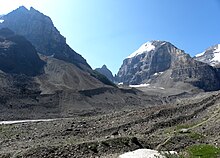Moraine
A moraine is any glacially formed accumulation of unconsolidated glacial debris (soil and rock) which can occur in currently glaciated and formerly glaciated regions, such as those areas acted upon by a past ice age. This debris may have been plucked off the valley floor as a glacier advanced or it may have fallen off the valley walls as a result of frost wedging. Moraines may be composed of debris ranging in size from silt-like glacial flour to large boulders. The debris is typically sub-angular to rounded in shape. Moraines may be on the glacier’s surface or deposited as piles or sheets of debris where the glacier has melted. Moraines may also occur when glacier- or iceberg-transported rocks fall into the sea as the ice melts.

Types of moraines
Lateral moraines

Lateral moraines are parallel ridges of debris deposited along the sides of a glacier. The unconsolidated debris is deposited on top of the glacier by frost shattering of the valley walls and from tributary streams flowing into the valley. The till is carried along the glacial margin until the glacier melts. Because lateral moraines are deposited on top of the glacier, they do not experience the postglacial erosion of the valley floor and therefore, as the glacier melts, lateral moraines are usually preserved as high ridges.

Lateral moraines stand high because they protect the ice under them from the elements, which causes it to melt or sublime less than the uncovered parts of the glacier. Multiple lateral moraines may develop as the glacier advances and retreats.
Ground moraines

Ground moraines are till covered areas with irregular topography and no ridges, often forming gently rolling hills or plains. It is accumulated under the ice by lodgement, but may also be deposited as the glacier retreats. In alpine glaciers ground moraine is located between the two lateral moraines. Ground moraine may be formed into drumlins by the overriding ice.
Rogen moraines
Rogen moraines or Ribbed moraines are a type of basal moraines that forms a series of ribs perpendicular to the ice flow in an ice sheet. The depressions between the ribbs are sometimes filled with water making the Rogen moraines look like tigerstripes on aerial photographs. Rogen moraines are named after Lake Rogen[1] in Härjedalen, Sweden, the landform’s type locality.
End or terminal moraines
End moraines or terminal moraines are ridges of unconsolidated debris deposited at the snout or end of the glacier. They usually reflect the shape of the glacier's terminus. Glaciers act much like a conveyor belt carrying debris from the top of the glacier to the bottom where it deposits it in end moraines. End moraine size and shape is determined by whether the glacier is advancing, receding or at equilibrium. The longer the terminus of the glacier stays in one place the more accumulation there will be. There are two types of end moraines, terminal and recession moraines. Terminal moraines mark the maximum advance of the glacier. Recessional moraines are small ridges left as a glacier pauses during its retreat. After a glacier retreats the end moraine may be destroyed by postglacial erosion.
Recessional moraine
A recessional moraine is in the form of a series of ridges running across a valley behind terminal moraine. They form during standstills in a glacier's retreat.[citation needed]
Medial moraine
A medial moraine is a ridge of moraine that runs down the center of a valley floor. It is formed when two glaciers meet and the debris on the edges of the adjacent valley sides join and are carried on top of the enlarged glacier. As the glacier melts or retreats, the debris is deposited and a ridge down the middle of the valley floor is created. The Kaskawulsh glacier in the Kluane National Park, Canada has a ridge of medial moraine 1 km wide.
Supraglacial moraines
Supraglacial moraines are created by debris accumulated above the glacial ice. This may occur by upwelling of debris inside the ice trough internal slide plains, melting of the uppermost layers or directly by material that falls into the glaciers.
Veiki moraine
A Veiki moraine is a kind of hummocky moraine that forms irregular landscapes of ponds and plateaus surrounded by banks. It is formed by the irregular melting of an ice covered with a thick layer of debris. Veiki moraine is common in northern Sweden and parts of Canada.
Wisconsin moraines
Moraines of today's glaciers are small compared to moraines of much larger glaciers of the Ice Age. Wisconsin's moraines, up to 300' high, and related glacial features, are considered among the most impressive in North America. Some of these moraines have been cut by roads and railroads (one now converted to the Ice Age Scenic and Glacial Drumlin Trails), allowing easy access to moraine and drumlin cross-sections. These ancient moraines are used today for a wide variety of recreational activities. Moraine stone has been washed clean by glacial rivers, so is well suited to be used as construction material.[2]
See also
- Glacial landforms
- List of landforms
- Drumlin
- Esker
- Gettlinge
- Tarn
- Moraine-dammed lake
- Geomorphology
- Cirque
- Dogger Bank
- Long Island
- Terminal moraine
- Moraine, Ohio
References
This article includes a list of references, related reading, or external links, but its sources remain unclear because it lacks inline citations. (February 2008) |
- Easterbrook, D. J. (1999) Surface processes and landforms. (Second Ed). Prentice Hall, Upper Saddle River, New Jersey.
- ^ Möller, P., 2006. Rogen moraine: an example of glacial re-shaping of pre-existing landforms. Quaternary Science Reviews, 25:362-389
- ^ USA National Park Service

